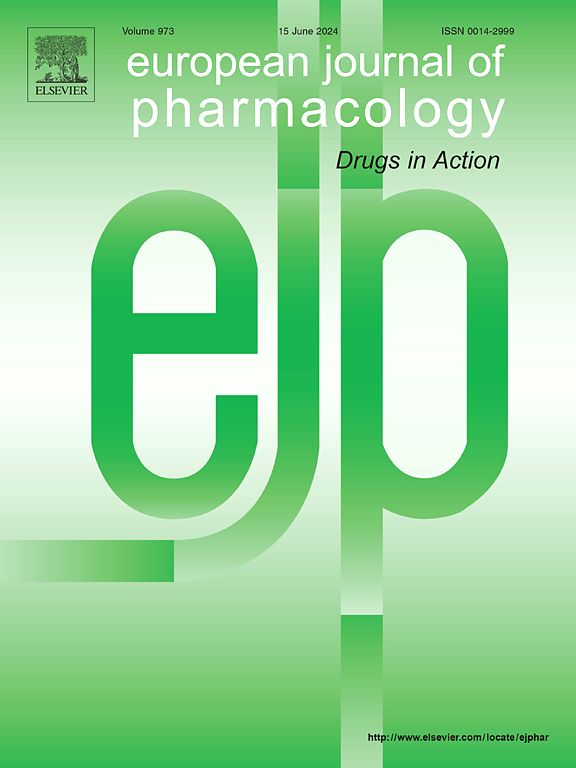“达格列净通过可能参与IL-17A/GSK3β信号通路和炎症细胞因子的调节来减轻脂多糖诱导的神经炎症”。
IF 4.2
3区 医学
Q1 PHARMACOLOGY & PHARMACY
引用次数: 0
摘要
背景:神经炎症通过多种机制驱动神经元变性和认知能力下降。白细胞介素(IL)-17A由Th17细胞分泌,激活糖原合成酶激酶3β (GSK3β),通过核因子κB (NF-κB)途径加重神经炎症。达格列净(DPG)是一种具有神经保护作用的钠/葡萄糖共转运蛋白2抑制剂,可减少氧化应激、细胞凋亡和炎症。本研究在lps诱导的大鼠模型中检测DPG对神经炎症的分子影响。方法:实验设对照组、脂多糖(LPS) (5 mg/kg,腹腔注射)、LPS+DPG (10 mg/kg灌胃)、DPG 4组,共32只雌性Wistar Albino大鼠。经过5天的治疗,这些老鼠被安乐死。收集脑和小脑组织进行生化分析,分光光度法检测氧化应激参数;组织和免疫染色分析侧重于caspase-9 (cas9)、NF-κB和IL-10的免疫表达,并通过qRT-PCR分析IL-17A、GSK3β、IL-6和环氧化酶2基因的表达。结果:LPS组出现充血、水肿、轻度变性、神经元死亡、中度胶质瘤。观察到cas9和NF-κB免疫表达增加,氧化应激参数增加,四个基因mRNA表达增加,IL-10和总抗氧化状态下降。DPG治疗显著逆转了所有这些结果,并保护神经元组织免受lps诱导的实质性神经元损伤。结论:DPG可能通过参与IL-17A/GSK3β通路,降低氧化应激,发挥神经保护作用;然而,需要进一步的研究来阐明因果机制和更广泛的抗炎作用。本文章由计算机程序翻译,如有差异,请以英文原文为准。
Dapagliflozin mitigates lipopolysaccharide-induced neuroinflammation through potential involvement of the IL-17A/GSK3β signaling pathway and modulation of inflammatory cytokines
Background
Neuroinflammation drives neuronal degeneration and cognitive decline through various mechanisms. Interleukin (IL)-17A, secreted by Th17 cells, activates glycogen synthase kinase 3 beta (GSK3β), worsening neuroinflammation via the nuclear factor kappa B (NF-κB) pathway. Dapagliflozin (DPG), a sodium/glucose cotransporter 2 inhibitor with neuroprotective effects, reduces oxidative stress, apoptosis, and inflammation. This study examines DPG's molecular impact on neuroinflammation in an LPS-induced rat model.
Methods
The experiment was designed with four groups as control, lipopolysaccharide (LPS) (5 mg/kg, intraperitoneal), LPS + DPG (10 mg/kg via oral gavage), and DPG, with a total of thirty-two female Wistar Albino rats. After five days of treatment, the rats were euthanized. Brain and cerebellum tissues were gathered for biochemical analysis to examine oxidative stress parameters spectrophotometrically; histological and immunostaining analysis focusing on caspase-9 (Cas-9), NF-κB, and IL-10 immunoexpressions, and genetic analysis as IL-17A, GSK3β, IL-6, and cyclooxygenase 2 gene expressions by qRT-PCR.
Results
Histopathological evaluation revealed hyperemia, edema, mild degeneration, neuronal death, and modest gliosis in the LPS group. Increment of Cas-9 and NF-κB immunoexpressions, oxidative stress parameters, and the mRNA expressions of all four genes, in addition to the decrement of IL-10 and total antioxidant status, have been observed. DPG treatment significantly reversed all these findings and protected the neuronal tissues against LPS-induced substantial neuronal damage.
Conclusion
In conclusion, DPG may exert neuroprotective effects through the involvement of the IL-17A/GSK3β pathway and reduction of oxidative stress; however, further studies are needed to clarify causal mechanisms and broader anti-inflammatory actions.
求助全文
通过发布文献求助,成功后即可免费获取论文全文。
去求助
来源期刊
CiteScore
9.00
自引率
0.00%
发文量
572
审稿时长
34 days
期刊介绍:
The European Journal of Pharmacology publishes research papers covering all aspects of experimental pharmacology with focus on the mechanism of action of structurally identified compounds affecting biological systems.
The scope includes:
Behavioural pharmacology
Neuropharmacology and analgesia
Cardiovascular pharmacology
Pulmonary, gastrointestinal and urogenital pharmacology
Endocrine pharmacology
Immunopharmacology and inflammation
Molecular and cellular pharmacology
Regenerative pharmacology
Biologicals and biotherapeutics
Translational pharmacology
Nutriceutical pharmacology.

 求助内容:
求助内容: 应助结果提醒方式:
应助结果提醒方式:


